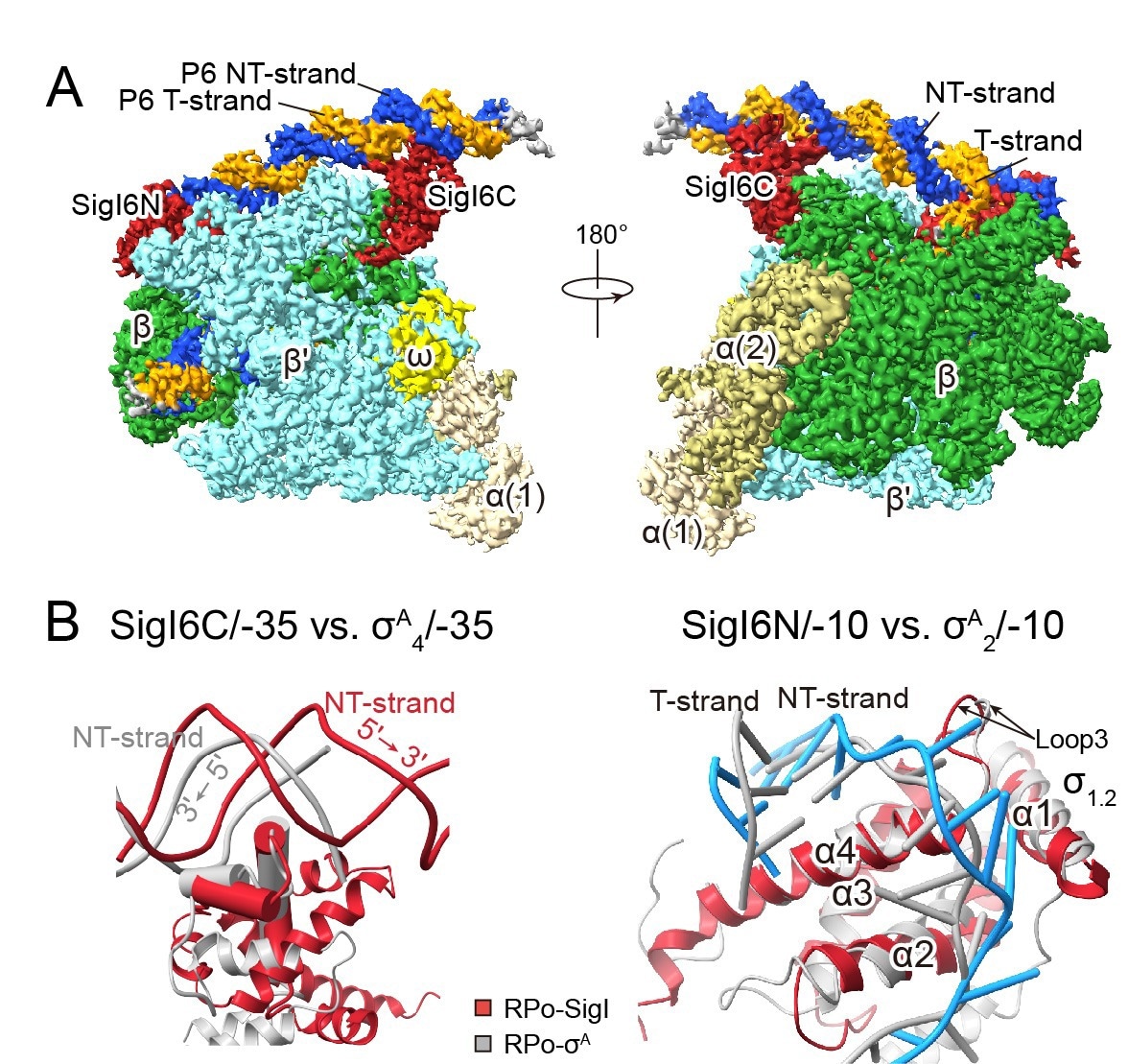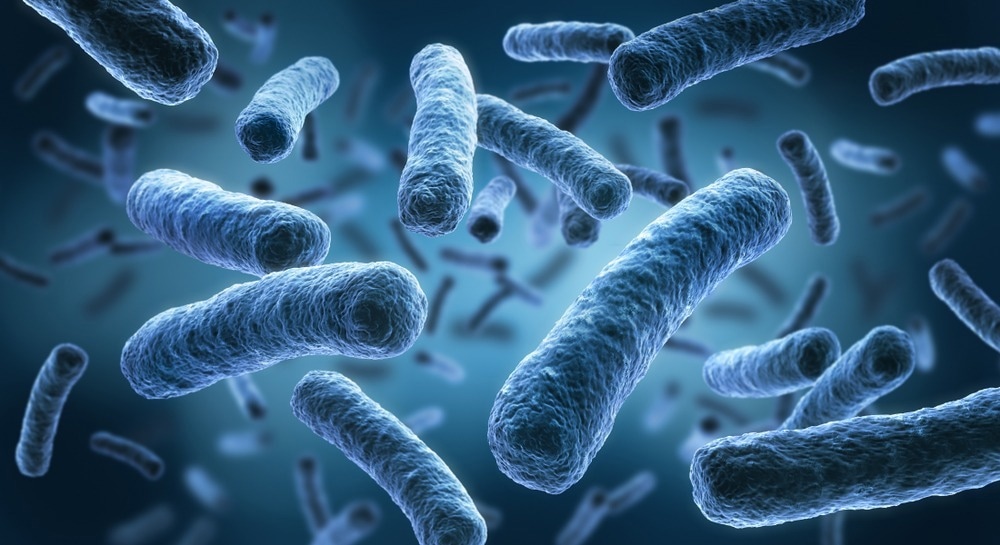Reviewed by Danielle Ellis, B.Sc.Nov 7 2023
Bacterial transcription serves as an assembly line for duplicating genetic directives from double-stranded DNA into RNA molecules. These RNA molecules are subsequently employed in the manufacturing of specific proteins required by the bacterium at that particular point in time.
 Cryo-EM structure of SigI6-RNAP-promoter complex. (A) The overall structure of the complex. Each of the subunits and DNA chains is colored differently. (B) The comparison of SigI and a canonical σ70 factor in -35 and -10 promoter recognition. Image Credit: Jie Li and Yingang Feng.
Cryo-EM structure of SigI6-RNAP-promoter complex. (A) The overall structure of the complex. Each of the subunits and DNA chains is colored differently. (B) The comparison of SigI and a canonical σ70 factor in -35 and -10 promoter recognition. Image Credit: Jie Li and Yingang Feng.
The supervisors of the assembly line in question are referred to as sigma factors. These sigma factors can be categorized into four distinct groups based on their structure and genetic makeup. However, one sigma factor, known as SigI, has long been considered an anomaly because it does not neatly fit into any of these four groups.
Recently, a team of researchers from the Qingdao Institute of Bioenergy and Bioprocess Technology (QIBEBT) at the Chinese Academy of Sciences (CAS) has shed new light on SigI's uniqueness.
Their study findings reveal that SigI is even more distinct than previously believed, to the extent that it necessitates the creation of an entirely new classification group. This discovery may have significant implications for the development of gene regulation tools.
The study was published in the journal Nature Communications on October 13th, 2023.

Image Credit: peterschreiber.media/Shutterstock.com
In bacterial transcription, sigma factors play a pivotal role in recognizing specific promoters, which are regions of genetic information located at the beginning of a DNA sequence necessary for generating a particular transcript. What makes this discovery even more intriguing is that different SigIs within the same bacterium can bind to different promoters to achieve precise recognition.
Despite being the subject of study for over two decades since their initial discovery, the molecular mechanism behind the specific promoter recognition by SigI during the transcription process had remained elusive.
The existence of multiple SigIs and their role regulating the expression of a super multienzyme complex, called cellulosome, in some bacteria for efficient degradation of plant biomass raised further questions about the mechanism of specificity between different SigIs.”
Yingang Feng, Study Co-Corresponding Author and Professor, Qingdao Institute of Bioenergy and Bioprocess Technology, Chinese Academy of Sciences
The researchers undertook the reconstruction of two transcription open complexes, one involving SigI1 and the other with SigI6.
They achieved this by using RNA polymerase extracted from the bacterium C. thermocellum, along with SigI factors obtained from E. coli and artificially synthesized promoters. Subsequently, they employed cryo-electron microscopy to unveil the structures of these complexes and conducted experimental analyses to assess their functionality.
Through a comprehensive examination of both structural and functional aspects, the researchers successfully addressed two significant issues: the classification of SigI factors and the specificity of their functions.
They discovered that SigI factors originating from cellulose-producing bacteria possess a previously unknown recognition mechanism for bacterial transcriptional promoters, establishing a distinct category of sigma factors in bacterial transcription.
These structural revelations unveiled two distinctive features of SigI, one of which is absent in other well-known sigma factors. These features enable SigI to adopt a unique recognition mode for promoters containing the -35 element.
SigI promoter recognition of the -35 element differs completely from that of other sigma factors in this family. The structures also showed that SigIs can recognize another promoter region known as -10 element using different features from the ones used by other sigma factors.”
Yingang Feng, Study Co-Corresponding Author and Professor, Qingdao Institute of Bioenergy and Bioprocess Technology, Chinese Academy of Sciences
The research team intends to further explore the role of SigI factors in the regulation of cellulosomes in C. thermocellum.
Although we have gained some knowledge of the SigI system in transcriptional regulation of cellulosome, the understanding of cellulosome regulation is still far from complete. C. thermocellum contains about 80 cellulosomal components, but only a small fraction of them were confirmed to be regulated under the control of the SigI system.”
Yingang Feng, Study Co-Corresponding Author and Professor, Qingdao Institute of Bioenergy and Bioprocess Technology, Chinese Academy of Sciences
Feng added, “Ultimately, our goal is to elucidate the molecular mechanisms governing the regulation of cellulosomes. With this knowledge, we hope to engineer cellulosome-producing bacteria to achieve a better cell factory for applications in bioenergy, synthetic biology and biotechnology.”
Source:
Journal reference:
Li, J., et al. (2023) Structure of the transcription open complex of distinct σI factors. Nature Communications. doi.org/10.1038/s41467-023-41796-4.